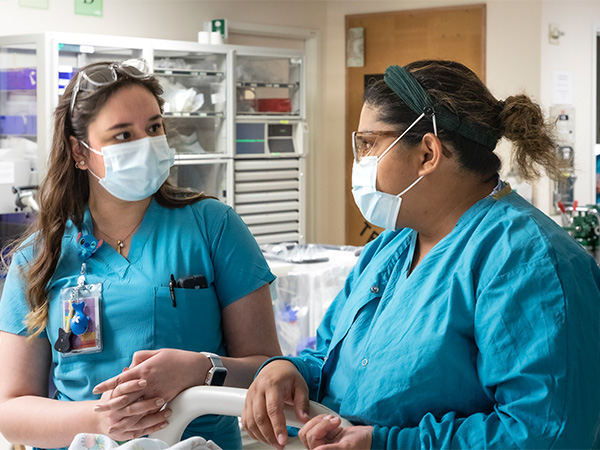Innovations and Improvements
Designing Forest B: A New Space Works Better for Patients and Nurses
Seattle Children’s opened the doors to Forest B, a much-needed addition to the hospital campus that creates new spaces for surgeries, cancer care, pharmacy, and other clinical and research areas. The space was designed to foster greater collaboration between research and clinical care, particularly for cancer patients — and to speed the integration of laboratory innovations into patient care. Forest B, opened in 2022, expands the hospital’s clinical footprint by 310,000 square feet and allows us to treat more patients to meet the growing demand for our services in the region.
 More than 35 nurses contributed suggestions and feedback on design plans with the building designers and planners. Gathering perspectives and ideas from nurses was key to designing features that solve real-world issues. Its dedicated amenities and respite spaces, for example, help workforce members recharge. The clinical areas were designed to help increase efficiencies, such as keeping supplies close to where they are needed. Changes like this and the thoughtfully designed physical environment give nurses more time to focus on patient care in the new spaces, which are aligned with their needs and match their workflow.
More than 35 nurses contributed suggestions and feedback on design plans with the building designers and planners. Gathering perspectives and ideas from nurses was key to designing features that solve real-world issues. Its dedicated amenities and respite spaces, for example, help workforce members recharge. The clinical areas were designed to help increase efficiencies, such as keeping supplies close to where they are needed. Changes like this and the thoughtfully designed physical environment give nurses more time to focus on patient care in the new spaces, which are aligned with their needs and match their workflow.
In the cardiac operating rooms, the space was designed to optimize everything from workstations, to monitors, to where equipment gets plugged in. Being able to collaborate with the design team allowed us to explain why things needed to be in a specific spot and how it affects patient care. We were most excited to see the little touches, such as designated bed spaces and storage nooks to keep hallways clear and facilitate patient transport — and an ice machine closer to patient areas to make it easy to get ice chips to patients.
“One of my favorite things about the new ORs is what we have been able to accomplish with a little extra space,” comments Kim Carris, a cardiac operating room charge nurse. Noting that now all the specialty supplies are in one central location, she says it is easier to grab things on the fly that she needs (suture, implants, instrumentation) without delaying patient care. “We now have designated space for supplemental equipment in our core, and that has made things much easier for the staff. We can move equipment and patients much more easily, which is so important with our complex patient population.”
A Patient-Centered Design
The benefits to patients are visible in Forest B’s light-filled spaces. For example, the Cancer and Blood Disorder Center’s new clinical space features a patient-centric design that provides a “universal room” where all services are coordinated. Before, the patient had to move around the clinic to different types of rooms staffed with different healthcare professionals. That setup led to appointment scheduling complexity, delays in care and longer stays for the patient.
“Now, patients have one room, and all their care comes to them: team and consult visits, blood draws, infusion and follow-up tests,” says Laura John, an infusion nurse in the Cancer and Blood Disorder Center and a Forest Innovation Team member. The new design reduces the amount of time a patient spends at the hospital and allows for streamlining scheduling and staffing.
“I am loving the new space. It just seems like everything is more efficient and patients don’t have to wait as long,” says Danielle Jones, an infusion nurse in the Cancer and Blood Disorder Center.
Because the universal room must be multipurpose to manage all aspects of patient care — holding a care conference, accessing a patient’s port, giving high-risk medications or managing patient emergencies — nurses and other clinicians evaluated everything in the room to ensure it would perform as intended. One innovative element introduced in the universal room is the patient recliner. This piece of furniture has to function as a recliner, a bed and an exam table. The resulting design is comfortable for the patient and functional for nurses — and is yet another example of how purposeful design can enhance our patient-centered focus.
With eight floors above ground and one below ground, the new building houses:
- 8 new operating rooms
- 2 new cardiac catheterization labs
- 20 new inpatient Surgical Unit beds
- New outpatient clinical space for the Cancer and Blood Disorders Center
- Additional retail pharmacy and inpatient pharmacy
- New clinical laboratory space
- New sterile processing space directly adjacent (internal elevators) to the operating rooms
Learn about this work and more in the 2022 Nursing Annual Report. (PDF)
Improving Urinary Tract Infection (UTI) Testing
Febrile infants younger than 90 days account for 5%-14% of emergency department (ED) visits annually in the United States. Many of these infants are diagnosed with a urinary tract infection (UTI), a common source of infection in the pediatric population.
Currently, the gold standard for UTI diagnosis is collecting a urine sample for urinalysis and urine culture. Standard of practice for a patient who is not toilet trained is to obtain a urine sample via one of two methods: urinary catheterization or suprapubic aspiration. Both ways of obtaining urine involve getting the urine by way of a tube inserted through the urethra or a needle inserted through the skin into the bladder. As such, these methods are invasive and introduce a risk of infection. Additionally, invasive methods can have adverse effects such as pain, dysuria and hematuria — as well as causing distress for the patient and family.
 Nurse-Led Effort
Nurse-Led Effort
Thus, a noninvasive method is preferable for many reasons. In 2022, Nurse Practitioner Fellow Megan Bianco initiated a program to train nurses and nurse technicians in the ED to perform a noninvasive bladder stimulation maneuver to obtain a urine sample. This maneuver was performed on all infants ages 0-6 months who required a urine sample over a 6-week period during winter 2022.
In all, 33 patients participated in the clean-catch urine sample trial. The mean patient age was 1.9 months. A total of 15 (45.5%) infants successfully provided a urine sample with the noninvasive bladder stimulation maneuver. Thus, this method spared slightly less than one half of the participating infants from an invasive urine collection via a catheter.
This trial demonstrates the noninvasive method is a viable way to collect urine samples in non-toilet-trained patients and prevents the adverse effects that can accompany invasive methods. Although the sample size was small, overall findings are consistent with evidence gathered via a literature review.
Improving the Patient and Family Experience
“I hope this pilot project ends up making UTI testing less uncomfortable for patients and families — when the patient and family are calm, it’s also easier for the nursing team to do their job and establish trust with the family,” notes Bianco.
This project assessed successes and barriers of implementing the noninvasive bladder stimulation maneuver in the ED. Project findings can be used to inform recommendations for the noninvasive maneuver to become standard of practice for all workforce members throughout Seattle Children’s who perform urine collection.
Learn about this work and more in the 2022 Nursing Annual Report. (PDF)
Working at Seattle Children’s
To reach our goals, we are committed to recruiting and retaining the best nurses. We invite you to search our current job openings.
Seattle Children’s provides opportunities for our nurses to learn and grow in an innovative environment while being in full partnership with other providers on multidisciplinary teams. We support and engage our nursing staff with training and educational opportunities, state-of-the-art-facilities and equipment, shared governance and comprehensive benefits.
When hiring, we look for nurses who share our passion for family-centered care and who practice at the top of their profession. Whether you are a new nursing graduate eager to participate in our healing environment, or a seasoned professional committed to advancing the practice of nursing, we welcome your application.